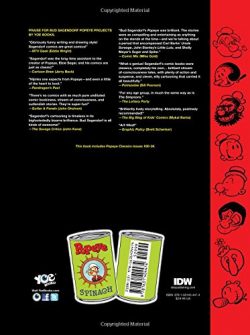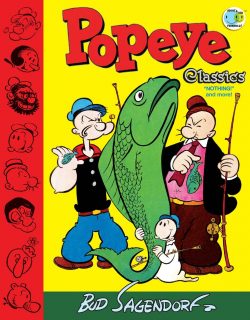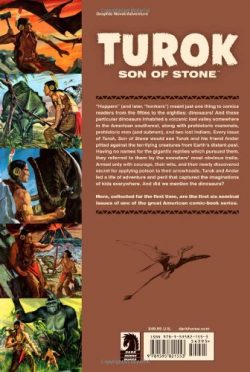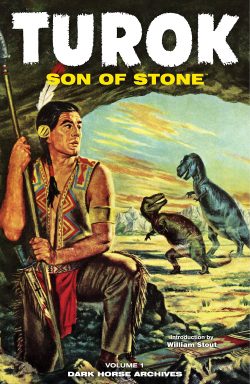

By Bud Sagendorf, edited and designed by Craig Yoe (Yoe Books/IDW)
ISBN: 978-1-63140-447-4 (HB) eISBN: 978-1-62302-786-5
How many cartoon classics can you think of still going after a century? Here’s one…
There are a few fictional personages to enter communal world consciousness – and fewer still from comics – but a grizzled, bluff, uneducated, visually impaired old sailor with a speech impediment is possibly the most well-known of that select bunch.
Elzie Crisler Segar was born in Chester, Illinois on 8th December 1894. His father was a general handyman, and the boy’s early life was filled with the solid, dependable blue-collar jobs that typified the formative years of his generation of cartoonists. Segar worked as a decorator, house-painter and also played drums; accompanying vaudeville acts at the local theatre.
When the town got a movie-house, Elzie played silent films, absorbing all the staging, timing and narrative tricks from keen observation of the screen. Those lessons would become his greatest assets as a cartoonist. It was while working as the film projectionist, at age 18, that he decided to become a cartoonist and tell his own stories.
Like so many others in those hard times, he studied art via mail, specifically W.L. Evans’ cartooning correspondence course out of Cleveland, Ohio, before gravitating to Chicago where he was “discovered” by Richard F. Outcault – regarded by most in the know today as the inventor of modern newspaper comic strips with The Yellow Kid and Buster Brown.
The celebrated pioneer introduced Segar around at the prestigious Chicago Herald. Still wet behind the ears, the kid’s first strip, Charley Chaplin’s Comedy Capers, debuted on 12th March 1916.
In 1918, Segar married Myrtle Johnson and moved to William Randolph Hearst’s Chicago Evening American to create Looping the Loop, where Managing Editor William Curley foresaw a big future for Segar and promptly packed the newlyweds off to New York: HQ of the mighty King Features Syndicate. Within a year Segar was producing Thimble Theatre, (launching December 19th 1919) in the New York Journal: a smart pastiche of cinema and knock-off of movie-inspired features like Hairbreadth Harry and Midget Movies, with a repertory of stock players acting out comedies, melodramas, comedies, crime-stories, chases and especially comedies for vast daily audiences. It didn’t stay that way for long…
The core cartoon cast included parental pillars Nana and Cole Oyl; their lanky, highly-strung daughter Olive; diminutive-but-pushy son Castor; and the homely ingenue’s plain and (very) simple occasional boyfriend Horace Hamgravy (latterly, just Ham Gravy). Thimble Theatre had successfully run for a decade when, on January 17th 1929, a brusque, vulgar “sailor man” shambled into the daily ongoing saga of hapless halfwits. Nobody dreamed the giddy heights that stubborn cantankerous walk-on would reach…
In 1924 Segar created a second daily strip. The 5:15 was a surreal domestic comedy featuring weedy commuter and would-be inventor John Sappo and his formidable wife Myrtle. This one endured – in one form or another – as a topper/footer-feature accompanying the main Sunday page throughout the author’s career, and even survived his untimely death, eventually becoming the trainee-playground of Popeye’s second great humour stylist: Bud Sagendorf.
After Segar’s premature passing in 1938, Doc Winner, Tom Sims, Ralph Stein and Bela Zambouly all took on the strip, as the Fleischer Studio’s animated features brought Popeye to the entire world, albeit a slightly variant vision of the old salt of the funny pages. Sadly, none had the eccentric flair and raw inventiveness that had put Thimble Theatre at the forefront of cartoon entertainments. And then, finally, Bud arrived…
Born in 1915, Forrest “Bud” Sagendorf was barely 17 when his sister – who worked in the Santa Monica art store where Segar bought his drawing supplies – introduced the kid to the master cartoonist who became his teacher and employer as well as a father-figure. In 1958, after years on the periphery, Sagendorf finally took over the strip and all the merchandise design, becoming Popeye’s prime originator…
With Sagendorf as main man, his loose, rangy style and breezy scripts brought the strip itself back to the forefront of popularity and made reading it cool and fun all over again. Bud wrote and drew Popeye in every graphic arena for 24 years. When he died in 1994, his successor was controversial “Underground” cartoonist Bobby London.
Young Bud had been Segar’s assistant and apprentice, and in 1948 became exclusive writer and artist of Popeye’s comic book exploits. The series launched in February of that year in a regular title published by America’s unassailable king of periodical licensing, Dell Comics.
On debut, Popeye was a rude, crude brawler: a gambling, cheating, uncivilised ne’er-do-well. He was soon exposed as the ultimate working-class hero: raw and rough-hewn, practical, but with an innate, unshakable sense of what’s fair and what’s not; a joker who wanted kids to be themselves – but not necessarily “good” – and someone who took no guff from anyone…
Naturally, as his popularity grew, Popeye mellowed somewhat. He was still ready to defend the weak and had absolutely no pretensions or aspirations to rise above his fellows, but the shocking sense of dangerous unpredictability and comedic anarchy he initially provided was sorely missed… except not in Sagendorf’s yarns…
Collected in this superb full-colour hardback/digital edition are Popeye #30-34, crafted by irrepressible “Bud”: collectively spanning September/November 1954 to October/December 1955. Stunning, nigh stream-of-consciousness slapstick sagas are preceded by an effusively appreciative ‘Society of Sagendorks’ briefing by inspired aficionado, historian and publisher Craig Yoe, offering a mirthful mission statement.
Augmenting that is another tantalising display of ephemera and merchandise in ‘A Bud Sagendorf Scrapbook’ presenting Coca-Cola Company-funded comic strip themed postcards distributed to WWII servicemen; original art, tin toys; a Popeye Chalkboard; Get Well Soon and Birthday card art plus images on cups and mugs.
We rejoin the ceaseless parade of laughs, surreal imagination and thrills with quarterly comic book #30, opening with text tale ‘The Bigger They Are -’ detailing, across the inside front-&-back covers, the story of Throckmorton …biggest tomcat in the world!
Another wild ride in begins in ‘Desert Pirates (a story of Evil Haggery)’ as Popeye’s ruthless nemesis The Sea Hag uses witchcraft, seduction, brainwashing and principally hamburgers to turn Wimpy into her weapon against the old sea salt. Naturally, when the hero blunders into her arid ambush, the scurvy faithless traitor then betrays her to Popeye – it’s just his nature…
An engaging Micawber-like coward, cad and conman, the insatiably ravenous J. Wellington Wimpy debuted in the newspaper strip on May 3rd 1931: an unnamed, decidedly partisan referee in one of Popeye’s pugilistic bouts.
Scurrilous, aggressively humble and scrupulously polite, the devious oaf struck a chord and Segar gradually made him a fixture. Preternaturally hungry, ever-keen to solicit bribes and a cunning coiner of many immortal catchphrases – such as “I would gladly pay you Tuesday for a hamburger today” and “Let’s you and him fight” – Wimpy was the perfect foil for our simple action hero and increasingly stole the entire show… and anything else unless it was very heavy or extremely well nailed down…
Follow-up yarn ‘Popeye An’ Swee’Pea in “Danger, Lunch!”’ resorts to tireless domestic themes as a quiet meal with Olive becomes an assault course after the anarchic and precocious “infink” gets bored and amuses himself with a hammer and chemistry set…
Smartly acknowledging a contemporary trend for sci fi fun, Sagendorf had introduced ‘Axle and Cam on the Planet Meco’ in #26: a robotic father and son indulging in wild romps on other worlds. Here they observe Earth television shows and the lads decides what his world needs is beanie hats, sidewalk refreshment stands and fun with dragons…
Cover-dated January/March 1955, #31 also opens and closes with a prose yarn adorning inside front and back. ‘Apple Vote!’ exposes the shocking behaviour of a retired racehorse with a sweet tooth after which ‘Thimble Theatre Presents Popeye An’ Swee’Pea in “Mud!”’ finds unconventional family unit Popeye, Swee’Pea and villainous reprobate Poopdeck Pappy deemed dysfunctional by Olive. Her eccentric efforts to save the kid and make him a gentleman are resisted by all involved with extreme vigour…
Just as the sailor man idly daydreams of being a monarch, the wacky ruler of Spinachovia returns in ‘Popeye and King Blozo in “Exile!” or “Bein’ King is Fer de Boids!!!”’ with the maritime marvel unwisely trading cap for crown and learning a salutary lesson about people in general and being careful of what you wish for, after which ‘Axle and Cam on the Planet Meco’ sees the mechanical moppet pay a fraught and frightening visit to Earth…
The issue concludes with a back cover strip starring ‘Popeye and Swee’Pea’ inspired by baby pictures…
Popeye #32 (April/June) opens with epic thrill-fest ‘Alone! or Hey! Where is Everybody? or Peoples is All Gone!’ as humans are abducted from all over the coast, leading the sailor man into another ferocious battle with evil machines and his most persistent enemy, after which our stars swap sea-voyages for western climes in “a tale of gold and cactus” entitled ‘Lorst!’
Set some years previously, the story reveals how Popeye made his fortune prospecting – despite and ultimately because of a little trouble with his newly adopted kid…
Sagendorf was a smart guy in tune with popular trends and fashions as well as understanding how kids’ minds worked. His tales are timeless in approach and delivery. As television exponential expanded, cowboys were king, with westerns dominating both large and small screens and plenty of comics. Thus, many episodes saw Popeye as a horse-riding sagebrush wanderer who ran a desert railroad when he wasn’t prospecting or exploring. I don’t think he ever carried a gun though…
The changing times dictated a shift in back-up features and the final ‘Axle and Cam on the Planet Meco’ exploit saw their world in chaos after Cam tried to transplant the human fashion for lawns to his own planet. Text tale ‘Catfish! detailed a meeting between fish feline and mutt and a wordless desert inspired back cover strip starring ‘Popeye and Swee’Pea’ wrapped thigs up.
The next issue (#33 July/September) offered a monochrome ‘Popeye and Swee’Pea’ house-wrecking short before main feature ‘Trouble-Shooter’ sees the tireless “hoomanitarian” set up as a helping hand for folk with troubles. Sadly, the gesture attracts some real nuts like cowardly King Hinkle of Moola who needs a patsy to fight rival ruler the King of Boola…
Returning to western deserts, Popeye and Swee’Pea swap sea-voyages for arid plains in ‘Monskers!’ and encounter a gigantic dinosaur which is not what it seems…
The replacement back-up feature was actually a return of Segar-spawned old favourites. Sappo was now hapless landlord to world’s worst lodger Professor O.G. Wotasnozzle, who callously inflicts the brunt of his genius on the poor schmuck. In ‘I’m the Smartest Man in the World!’, the lunatic fringe scientist decides to end late payment harassment by uninventing money…
A prose vignette reveals the fate of cowboy pony George who has ‘A Long Tail!’, before the fun pauses with a back-cover baseball gag starring Popeye An’ Swee’Pea.
The year and this archive close with #34, starting with more ‘Popeye An’ Swee’Pea’ baseball exploits on the monochrome inside front cover before Thimble Theatre Presents sailor man, Olive, Wimpy and the kid who endure a nautical nightmare storm that leaves our cast castaway on an island of irascible, invisible folk in eponymous saga ‘Nothing!’
Next, Popeye An’ Swee’Pea revisit western deserts to dig in the dirt and face ‘Uprising! or The Red Man Strikes Back! or Birds of a Feather!’ as the kid contends with and eventually befriends Indian infant Big Chief Thunder Eagle Jr. Sadly their play war on the white man is misunderstood by Wimpy who calls in not the cavalry but the US Army…
The manic mirth multiplies exponentially when Professor O.G. Wotasnozzle proves his insane ingenuity and dangerous lack of perspective in ‘Stop Thief!! or Please Halt! or Burglarproof House!’ before the fun concludes with one last text treat in transformative tale ‘Fish Fly!’ and a back cover gag proving why adults like Popeye should listen to kids like Swee’Pea…
Outrageous and side-splitting, these all-ages yarns are evergreen examples of narrative cartooning at its most surreal and inspirational. Over the last nine decades Thimble Theatre’s most successful son has unfailingly delighted readers and viewers around the world. This book is simply one of many, but each is sure-fire, top-tier entertainment for all those who love lunacy, laughter, frantic fantasy and rollicking adventure. If that’s you, add this compendium of wonder to your collection.
Popeye Classics volume 7 © 2015 Gussoni-Yoe Studio, Inc. All Rights Reserved. Popeye © 2015 King Features Syndicate. ™ Heart Holdings Inc.


